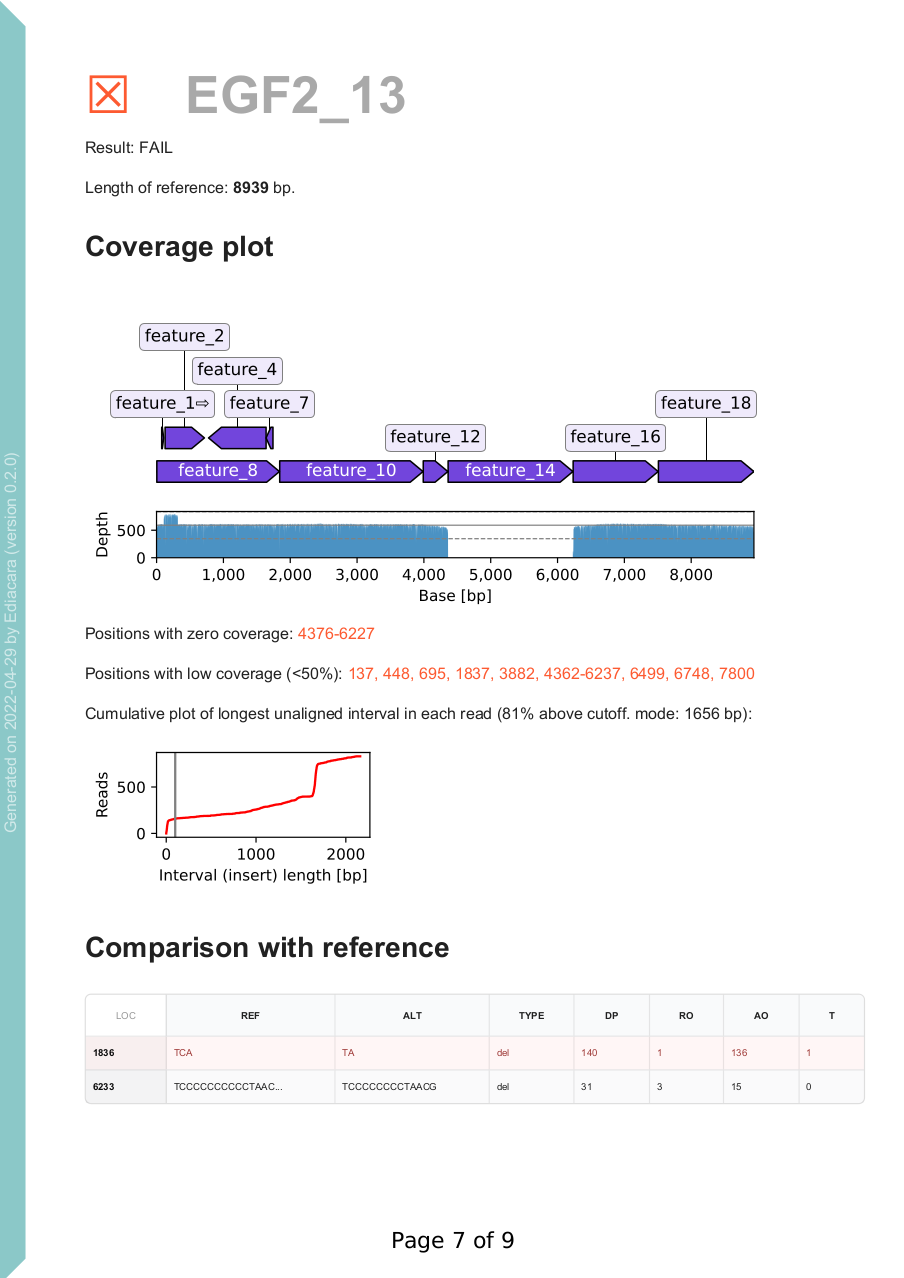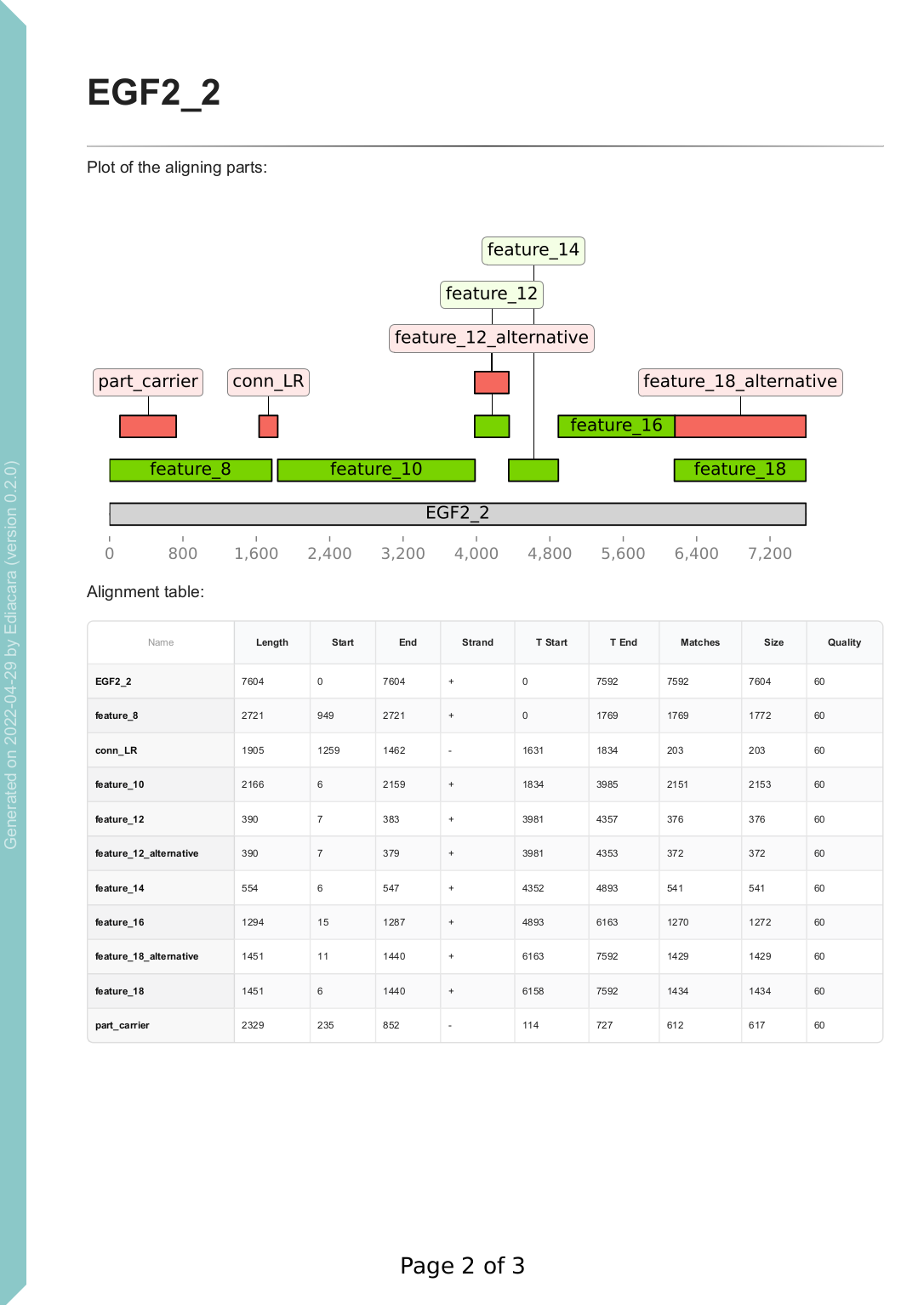Ediacara helps interpreting sequencing data of assembled DNA constructs (plasmids). It's used in the Sequeduct pipeline.
# pip install ediacara
pip install --upgrade git+https://github.com/Edinburgh-Genome-Foundry/Ediacara.git@mainThe plotting feature requires NCBI BLAST+. On Ubuntu, install it with:
apt-get install ncbi-blast+Using Ediacara requires the plasmid reference sequences (Genbank), the alignments in PAF format, and a TSV file of coverage (depth) counts. Optionally, the user can also specify consensus (or de novo assembly) files that will be compared with the references.
Minimap2 can create SAM or PAF alignments from fastq and reference fasta files.
paftools.js can convert from SAM to PAF.
The TSV file is the output of samtools depth -aa.
Canu can create an assembly file from filtered FASTQ reads that align best to the reference.
If we don't have sequencing data, Badread can be used to simulate fastq files from reference sequences.
An example for creating alignments in the terminal, for a reference named ABC_1:
# badread simulate --reference ABC_1.fa --quantity 100x --length 5000,500 > ABC_1.fastq
minimap2 -a ABC_1.fa ABC_1.fastq > ABC_1.sam
samtools sort -O sam -T sample.sort -o ABC_1_sorted.sam ABC_1.sam
samtools depth -aa ABC_1_sorted.sam > ABC_1.tsv
paftools.js sam2paf ABC_1.sam > ABC_1.pafCreate a de novo assembly with Canu:
./canu-2.1.1/bin/canu -p egf -d ABC_1 genomeSize=8k -nanopore filtered_fastq/ABC_1_filtered.fastqCreate a PDF report in Python with Ediacara:
import ediacara as edi
import dnacauldron # for loading sequence files
tsv_file = "/path/to/ABC_1.tsv"
tsv = edi.ComparatorGroup.load_tsv(tsv_file)
paf_path = "/path/to/ABC_1.paf"
paf = edi.ComparatorGroup.load_paf(paf_path)
reference_paths = ["/path/to/ABC_1.gb"]
records = dnacauldron.biotools.load_records_from_files(files=reference_paths, use_file_names_as_ids=True)
references = {record.id: record for record in records}
alignments = {"paf": paf, "tsv": tsv}
comparator_group = edi.ComparatorGroup(references, alignments)
assembly_paths = {"ABC_1": "/path/to/canu_assembly/ABC_1/egf.contigs.fasta"}
comparator_group.perform_all_comparisons(assembly_paths=assembly_paths)
# Write a PDF report on all constructs:
edi.write_comparatorgroup_report("report_ABC.pdf", comparator_group)This page of the report shows a missing part ('feature_14'). The presence of unaligned read segments suggest that there is another ~1.6 kbp sequence in its place (this was the part's carrier plasmid in this case). The correct section also contains a point mutation as seen in the red row of the variant call table. Suspected false positives (systematic sequencing errors) are shown in grey.
If we want to investigate which of the parts are present in the construct, we can align the part sequences against the consensus or de novo sequence, and create PDF report:
assembly = edi.Assembly(
assembly_path="/path/to/canu_assembly/ABC_1/egf.contigs.fasta",
reference_path="/path/to/ABC_1.gb",
alignment_path="/path/to/ABC_1_part_alignment.paf",
assembly_plan=assembly_plan,
)
assemblybatch = edi.AssemblyBatch(assemblies=[assembly], name="EGF review")
assemblybatch.perform_all_interpretations_in_group()
edi.write_assembly_analysis_report("review_report_pdf", assemblybatch)The plot shows alignment regions as annotations: green annotations (genetic parts) are expected in the construct; red annotations show other parts that align to the construct. Grey shows the alignment of the reference expected sequence for the plasmid. In this case, we have no errors as the green segments cover the whole sequence, and the reference aligns fully as well.
Ediacara uses the semantic versioning scheme.
Copyright 2021 Edinburgh Genome Foundry, University of Edinburgh
Ediacara was written at the Edinburgh Genome Foundry by Peter Vegh, and is released under the GPLv3 license.



